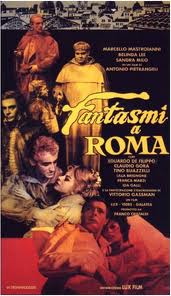
1961
Aka Phantom Lovers, Fantasmi a Roma, Les joyeux fantômes
100 minutes
Italy
Based on an idea by Sergio Amidei
A Franco Cristaldi production for Lux Film, Vides Cinematografica, Galatea Film
Distributed by Lux Film
Director: Antonio Pietrangeli
Story: Sergio Amidei, Ennio Flaiano, Antonio Pietrangeli, Ettore Scola, Ruggero Maccari
Screenplay: Ennio Flaiano, Antonio Pietrangeli, Ettore Scola, Ruggero Maccari
Cinematography: Giuseppe Rotunno
Music: Nino Rota
Editor: Eraldo Da Roma
Art director: Vincenzo Chiari, Vincenzo Del Prato
Cast: Marcello Mastroianni (Reginaldo/Federico di Roviano/Gino), Vittorio Gassman (Giovan Battista Villari, aka “Caparra”), Sandra Milo (Flora), Tino Buazzelli (Fra’ Bartolomeo), Eduardo De Filippo (Principe Annibale di Roviano), Belinda Lee (Eileen), Claudio Gora (Telladi), Evelyn Stewart (Carla), Franca Marzi (Nella), Lilla Brignone (‘the queen’), Enzo Maggio (Fricandò), Alberto De Amicis (manager of “City Song”), Enzo Cerusico (Cascamorto), Claudio Catania (Poldino), Michele Riccardini (Antonio, the caretaker), Bruno Scipioni (Otello, the plumber), Grazia Collodi (Marisina), Duilio D’Amore (Sor Augusto), Mario Maresca (Randoni, the art critic), Graziella Galvani (maths teacher), Luciana Gilli, Anna Maria Di Pace (schoolgirl), Antoinette Weynen, Elvira Tonelli, Antonella Della Porta, Nadia Marlowa
Here’s another excellent comedy from Antonio Pietrangeli, the well respected – but rather forgotten – director of classics such as Adua e le compagne and Io la conoscevo bene. Made in 1961, at just about the peak of his career, Ghosts of Rome was a high-profile release, put together by Franco Cristaldi for a prestigious trio of production houses (Galatea Film, Lux Film and Vides Cinematografica), which between them had a hand in most of the high-points of Italian cinema of the 1950s and 1960s. With such backing, it’s not surprising that it managed to attract an astonishing selection of talent, from scriptwriters (Fellini regular Ennio Flaiano, Oscar nominated neo-realist Sergio Amidei and Pietrangeli regulars Ruggero Maccari and Ettore Scola) to the quite astonishing cast.
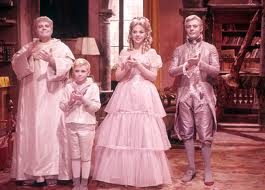
A whimsical fantasy with bite, the story follows Don Annibale (Eduardo De Filippo), the elderly Prince of Roviano and custodian of the crumbling family pile in the heart of Rome. It’s a palace with a not inconsiderable history and, as Don Annibale is very aware, home to a not inconsiderable amount of family ghosts, all of whom have prowled around the environs for many years. There’s Reginaldo (Marcello Mastroianni), a two-bit Casanova from the eighteenth century; Flora (Sandra Milo), a doomed romantic from a few generations later who drowned herself after an unfortunate love affair; and Father Bartolomeo (Tino Buazzelli), a greedy monk who died in an unfortunate accident – eating poisoned meatballs intended for rats – way back in 1653.
Everything changes when Don Annibale is killed in an unfortunate plumbing incident. His gadabout nephew, Federico (Mastroianni again) turns up with his stroppy stripper girlfriend, Eileen (Belinda Lee), and the first thing they do is contact a rich engineer, Tellandi (Claudio Gora), who has been trying to buy the palace for years in order to knock it down, build a department store and make a hefty profit. The ghosts are, unsurprisingly enough, rather upset with this turn of events, and decide to do their best to stymie the developers’ plans. They start off by instigating a series of minor irritations – hindering the workmen, etc – but then hit upon a master-plan: co-opting the ghost of a renaissance artist (Vittorio Gassman) to paint a fresco in the attic, hoping that when it’s discovered the building will be declared a place of historical interest and therefore subject to a conservation order.
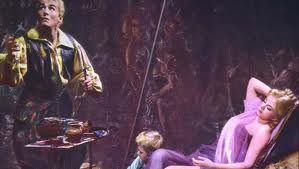
This is a delightful film which, as with the best of the commedia all’Italiana, masks some incisive comments about Italian society under its amiable exterior. There’s some visual humour – such as when Reginaldo falls for a transvestite nightclub singer – but on the whole it’s a character driven piece which relies on dialogue and comic interplay. A lot of the comedy comes from the ghost’s attempts to come to grips with the modern life which is increasingly encroaching on their world; something which both perplexes and invigorates them. Underneath this, though, it has interesting things to say about modern society: the search for profit above art and culture, the corruptibility of supposedly estimable figures (such as the art historian who accepts a bribe in exchange for claiming il Caparra’s painting is a fake) and the superficiality – albeit enjoyable superficiality – of La dolce vita. It also has a slightly melancholic undertone, with both Don Annibale and his ghosts being representative of a way of life that’s a thing of the past. Although, ironically, Federico ends up as a virtual carbon copy of his uncle, frequenting the same restaurants, preserving the same dusty family mementos and living with the same ghosts; despite all the changes, everything remains pretty much the same.
Beyond that, it’s beautifully photographed by Giuseppe Rotunno (The Leopard, Amarcord etc. etc.) and has lovely art direction. Pietrangeli’s direction is spot on, and possibly the only criticism that I can come up with is that the second part of the film – in which the ghosts seek to foil the developers and Federico slowly reconnects with his family heritage – passes too quickly and is possibly a little underplayed. In any other film, this would have provided the meat of the story, but here it’s almost secondary to the build up. But that’s a minor quibble, it’s a neat idea, well made and fabulously performed. The ghosts are beguiling creatures, for which credit is due to Mastroianni, Gassman, Milo and Buazzelli, and there are entertaining cameos from the likes of Enzo Maggio (as an angry chef) and Lilla Brignone (as a nutty old woman who thinks she’s a Queen).
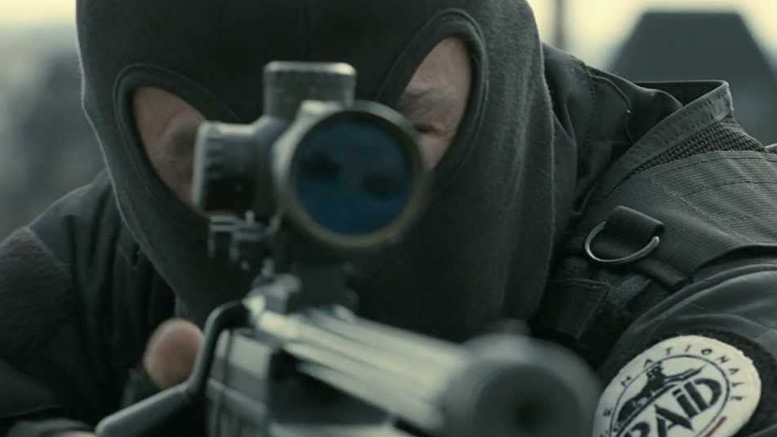
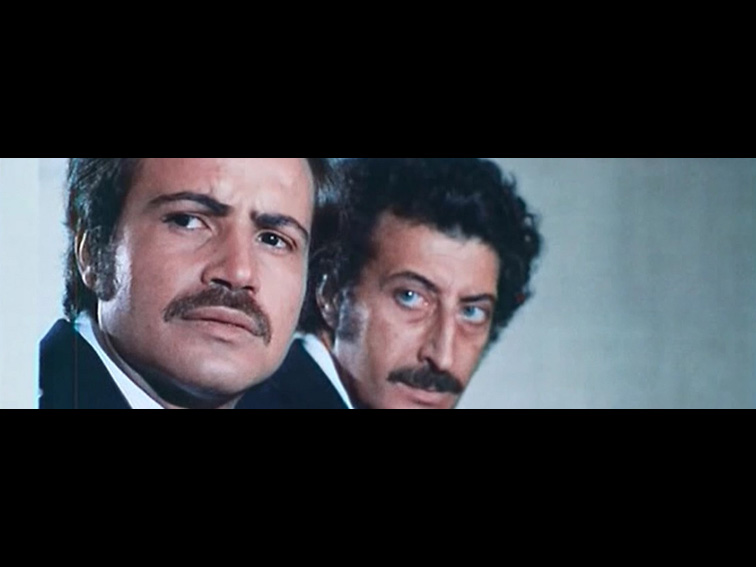
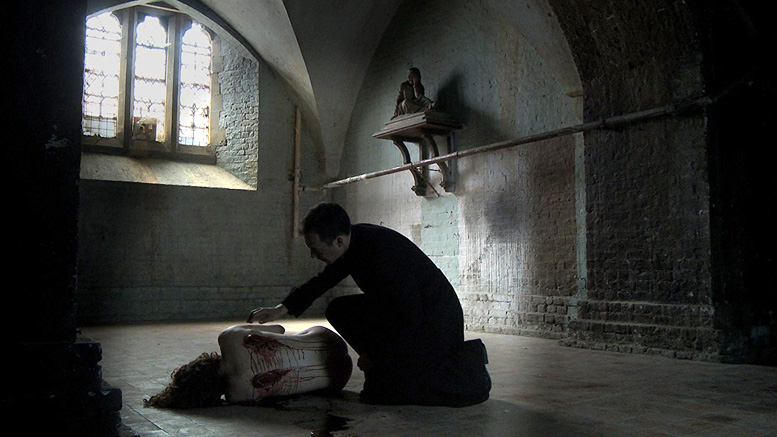
absolutely. Most of Pietrangeli’s work is worth searching for, some in libraries, some on youtube, some on amazon, region 2. Too bad it took me a half century to discover him.
Delightful but underrated film;
I think it inspired the well-known Ghost (1990).